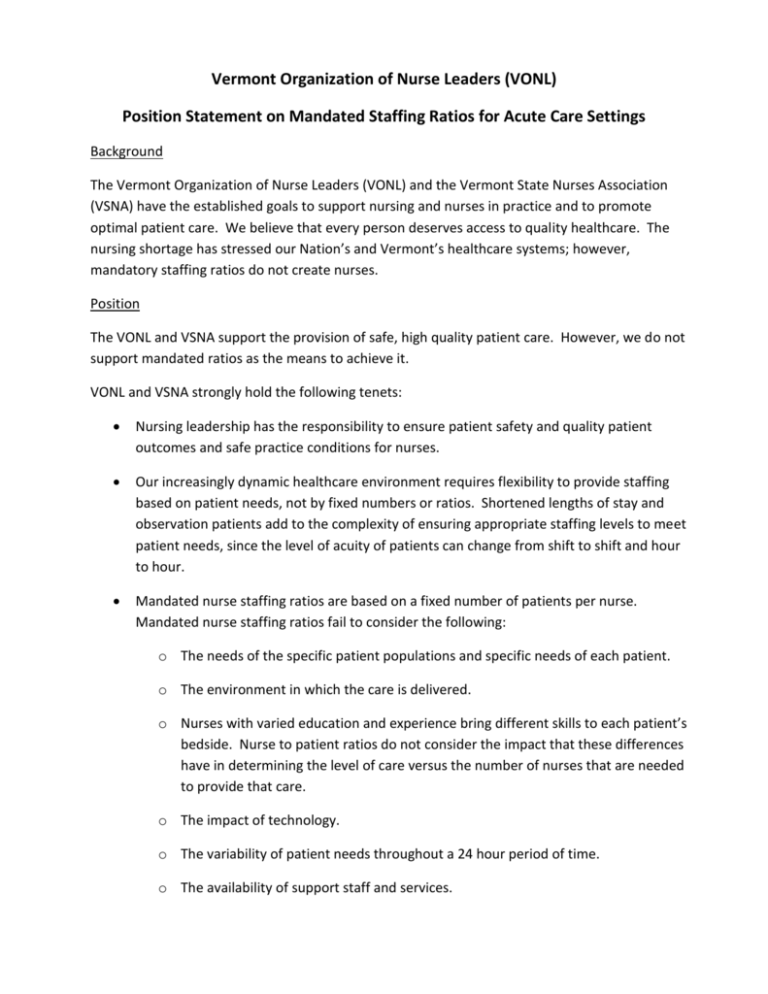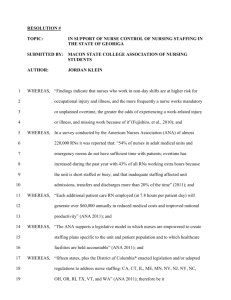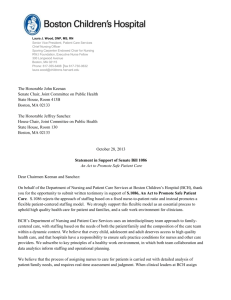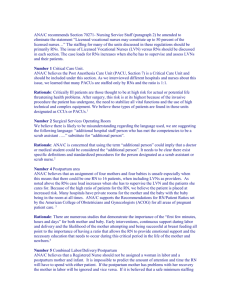Staffing Ratios for the Acute Care Setting
advertisement

Vermont Organization of Nurse Leaders (VONL) Position Statement on Mandated Staffing Ratios for Acute Care Settings Background The Vermont Organization of Nurse Leaders (VONL) and the Vermont State Nurses Association (VSNA) have the established goals to support nursing and nurses in practice and to promote optimal patient care. We believe that every person deserves access to quality healthcare. The nursing shortage has stressed our Nation’s and Vermont’s healthcare systems; however, mandatory staffing ratios do not create nurses. Position The VONL and VSNA support the provision of safe, high quality patient care. However, we do not support mandated ratios as the means to achieve it. VONL and VSNA strongly hold the following tenets: Nursing leadership has the responsibility to ensure patient safety and quality patient outcomes and safe practice conditions for nurses. Our increasingly dynamic healthcare environment requires flexibility to provide staffing based on patient needs, not by fixed numbers or ratios. Shortened lengths of stay and observation patients add to the complexity of ensuring appropriate staffing levels to meet patient needs, since the level of acuity of patients can change from shift to shift and hour to hour. Mandated nurse staffing ratios are based on a fixed number of patients per nurse. Mandated nurse staffing ratios fail to consider the following: o The needs of the specific patient populations and specific needs of each patient. o The environment in which the care is delivered. o Nurses with varied education and experience bring different skills to each patient’s bedside. Nurse to patient ratios do not consider the impact that these differences have in determining the level of care versus the number of nurses that are needed to provide that care. o The impact of technology. o The variability of patient needs throughout a 24 hour period of time. o The availability of support staff and services. Staffing decisions require critical thinking, judgment and flexibility of nurses who best understand the patients and their healthcare needs. This needs to be a collaborative process between nursing management and direct care staff. Unintended consequences of mandated staffing ratios could include cutbacks in services, bed closures, emergency room diversions, layoffs of LPNs and LNAs and increased healthcare costs. In addition, minimum staffing ratios easily translate into maximum ratios which potentially contradict the needs of both the patients and staff. Mandatory staffing ratios will increase the stress on our already burdened healthcare system and potentially create a greater public risk. We recognize that research demonstrates that it is the registered nurse who strongly impacts quality of care; and that all proposed staffing ratio legislation identifies only the registered nurse in the nurse patient ratio. However, such ratios fail to consider the impact and valuable contributions of both the LNA and LPN members of the nursing team. VONL and VSNA hereby issue the following position statement on staffing: Nurse staffing is critical to the delivery of quality patient care; Staff nurses are the essential resource in identifying patient characteristics and the number of patients for whom care may be safely provided by available staff; Identifying and maintaining appropriate numbers and skill mix of nursing staff is a challenge experienced by staff nurses and nurse managers in all settings; Staffing levels should be based on achieving quality patient care outcomes and meeting organizational goals, while providing for an organizational environment that supports the quality of nurses’ work life; Therefore be it resolved, that the VONL and VSNA are in support of the following principles* as a framework for nurse staffing for Vermont’s providers of healthcare: I. Patient Care Unit Related Appropriate staffing levels for a patient care unit reflect analysis of individual and aggregate patient needs. Staffing is most appropriate and meaningful when organizations identify a measure or unit of intensity that takes into consideration the aggregate population and the associated roles and responsibilities of nursing staff. Unit functions necessary to support the delivery of quality patient care must also be considered in determining staffing levels. II. Staff Related The specific needs of various patient populations should determine the appropriate clinical competencies required of the nurse practicing in that area. Registered nurses must have nursing management support and representation at both the operational and executive level. Clinical support from experienced, expert RNs should be readily available to those novice RNs with less proficiency. Educational preparation and experience must be considered when transitioning newly hired nurses into the workforce. III. Institutional/Organizational Related Organizational culture and policies should reflect a climate that values registered nurses and other employees as strategic assets and exhibits a true commitment to recruiting for budgeted positions. Organizational culture and policies should reflect a commitment to the retention of registered nurses and all employees. All institutions should have documented competencies for nursing staff, including agency and traveling RNs, for those activities that they are authorized to perform. Organizational policies should recognize the myriad needs of both patients and nursing staff. Organizational culture should reflect a commitment to safety where staff nurses’ voices are solicited and influential in staffing decisions. Date of Origin: March 10, 2003 Updated: July 2010 Approved by Membership 9/17/2010 * Based on principles adopted by the American Nurses Association. jill/vonl/positionstatement









